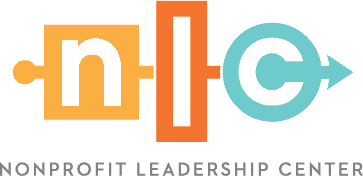According to research from the Project Management Institute, the biggest predictor of a project’s success — or failure — is communication. Their report found that project managers should spend 90% of their time on communications to ensure a project’s success, and up to 56% of revenue could be lost due to poor communication. So, how can your nonprofit communicate more effectively to achieve its intended impact?
Nonprofit Leadership Center trainer and communications coach, BeverlyAnn Foster, offers five tips for navigating team dynamics to communicate with confidence.
1. Practice M.I. communication.
When communicating with others, actively think about choosing (M)eaningful words and taking an (I)nterpersonal approach that is inclusive and purposeful.
First, using words correctly can make the difference between a successful and unsuccessful transfer of a message. The denotation of your language represents the literal or primary meaning of a word, and your connotation is an idea or feeling evoked in addition to the word’s literal or primary meaning. Both are different for everyone, so be sure to clarify your meaning to convey your intent.
Second, use verbal and nonverbal communication. Nonverbal communication is powerful because it can “fill in the blanks.” Body language, facial expressions and gestures can be interpreted intentionally and unintentionally, where verbal communication uses specific and concrete words rather than relying on assumption. Verbal communication is more personal and repetitive, helping to convey what we mean and successfully transfer a message.
2. Identify your listening style.
Active and engaged listening is essential to effective communication. Knowing your listening style can help you avoid common communications roadblocks, such as message overload and complexity, pre-occupation and prejudgment. There are four listening styles:
- People-Oriented: A listener who is more interested in the person speaking, with the potential to become more interested in a topic by way of the speaker.
- Action-Oriented: A listener who wants to “do something.” They do not need the research behind a topic or the “why,” just “what” needs to be done.
- Content-Oriented: A listener solely concerned with the facts and having a clear presentation delivered. They are all about the message.
- Time-Oriented: A listener who does not want a lot of detail and is more concerned with getting to the point.
Hint: When practicing active and engaged listening, avoid interruption or evaluation, stay focused on the speaker, organize the flow of information, and provide feedback.
3. Know how to support your team.
Healthy team dynamics promote a more collaborative workplace, a healthier culture, and more productive teamwork. Support your team confidently and effectively by:
- Acknowledging roles and responsibilities: Establish clear norms, be consistent with your message, and understand each team member’s strengths to bring confidence to tasks. Be careful to assign or agree to a task without first understanding all of its components.
- Fostering rest and recovery: Regularly assess workloads and encourage your team to unplug after work hours to promote a supportive environment at your nonprofit.
- Avoiding pet peeves: Refrain from cell phone use, interrupting, eating food during meetings, showing up unprepared, and veering into off-topic conversation. These may slow and often prevent effective communication.
4. Make problem-solving a habit.
Although inter-group conflict is often perceived as negative, differences in opinion should be encouraged. Providing an opportunity for growth, make problem-solving a habit in your organization by considering John Dewey’s 6 Reflective Thinking steps:
- Identify and define the problem. What is the conflict about?
- Analyze the problem. What are the circumstances surrounding the conflict?
- Suggest possible solutions. What can be done to improve or change its outcome?
- Compare solutions. What are similarities and differences between each proposal?
- Select the best solution. Which idea will generate the most preferred outcome?
- Implement the solution. Put your team’s problem solving to the test!
5. Promote a positive team culture.
Language and culture are interconnected. Where we are raised, the language we learn, and the rules and norms we’re exposed to affect how we communicate. Communication becomes more complex as cultural diversity increases, but this is NOT a bad thing! To promote a positive team culture be sure to:
- Encourage open communication. Give teammates time to share ideas and consider other perspectives. Ask clarifying questions and use verbal cues such as “Go ahead” or “I’m listening” to indicate you are actively listening and promote collaboration across your team.
- Avoid ethnocentrism. Cultivate cultural awareness by recognizing that cultural differences exist. Be sensitive and flexible by rephrasing statements to avoid slangs. Challenge stereotypes and avoid seeing your own culture as superior or comparing to another’s. Curiosity is the key, not judgement!
- Set common goals. Define a clear purpose for communicating and check for your team’s understanding. Use feedback loops to ensure that you are all on the same page and working toward the same goals.
Improve Team Dynamics at Your Nonprofit
Ready to become a better communicator and leader? Explore our upcoming training classes and certificate programs that help nonprofit professionals at all levels of expertise and experiences grow their skillset, knowledge and improve team dynamics.


